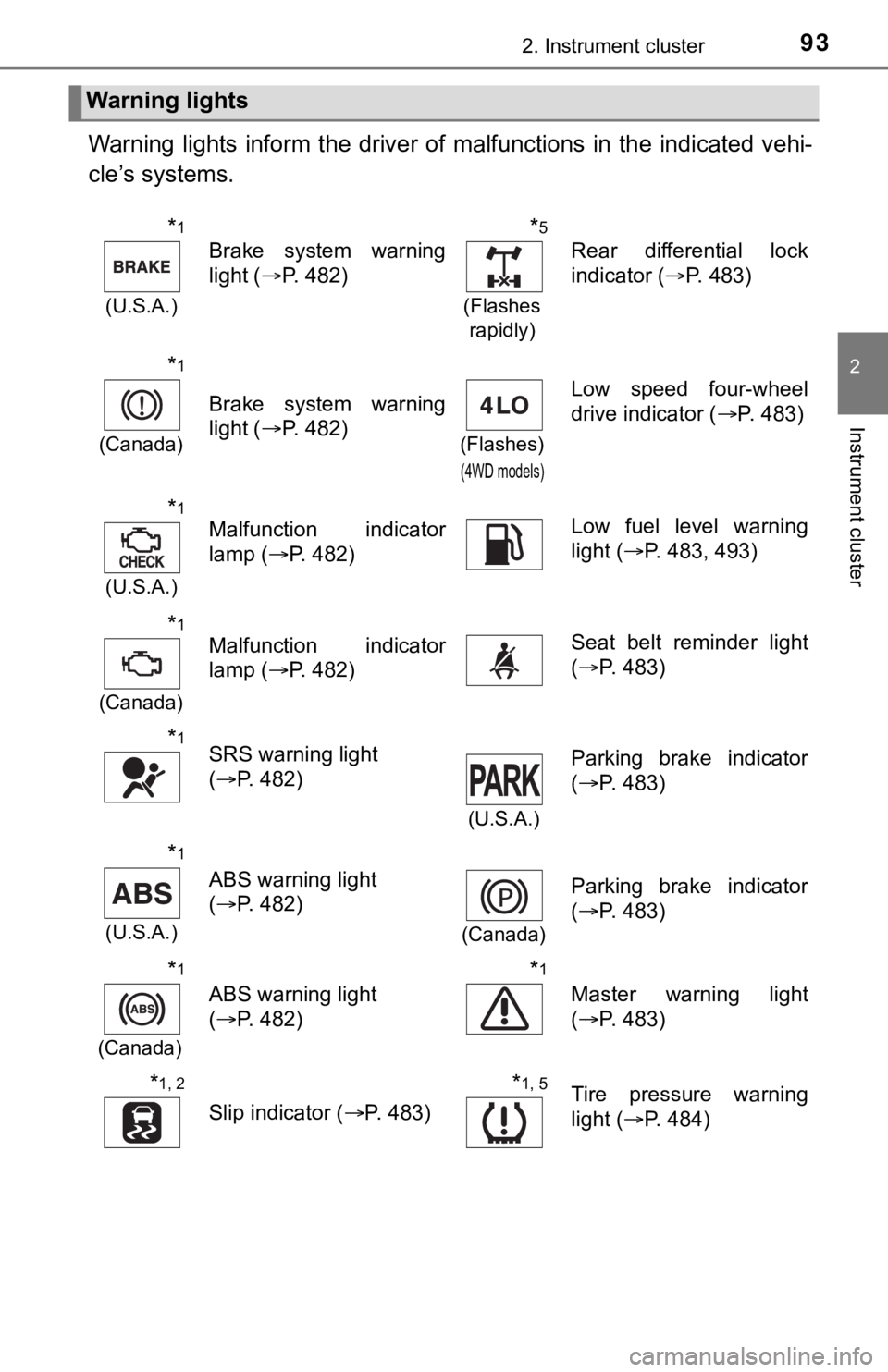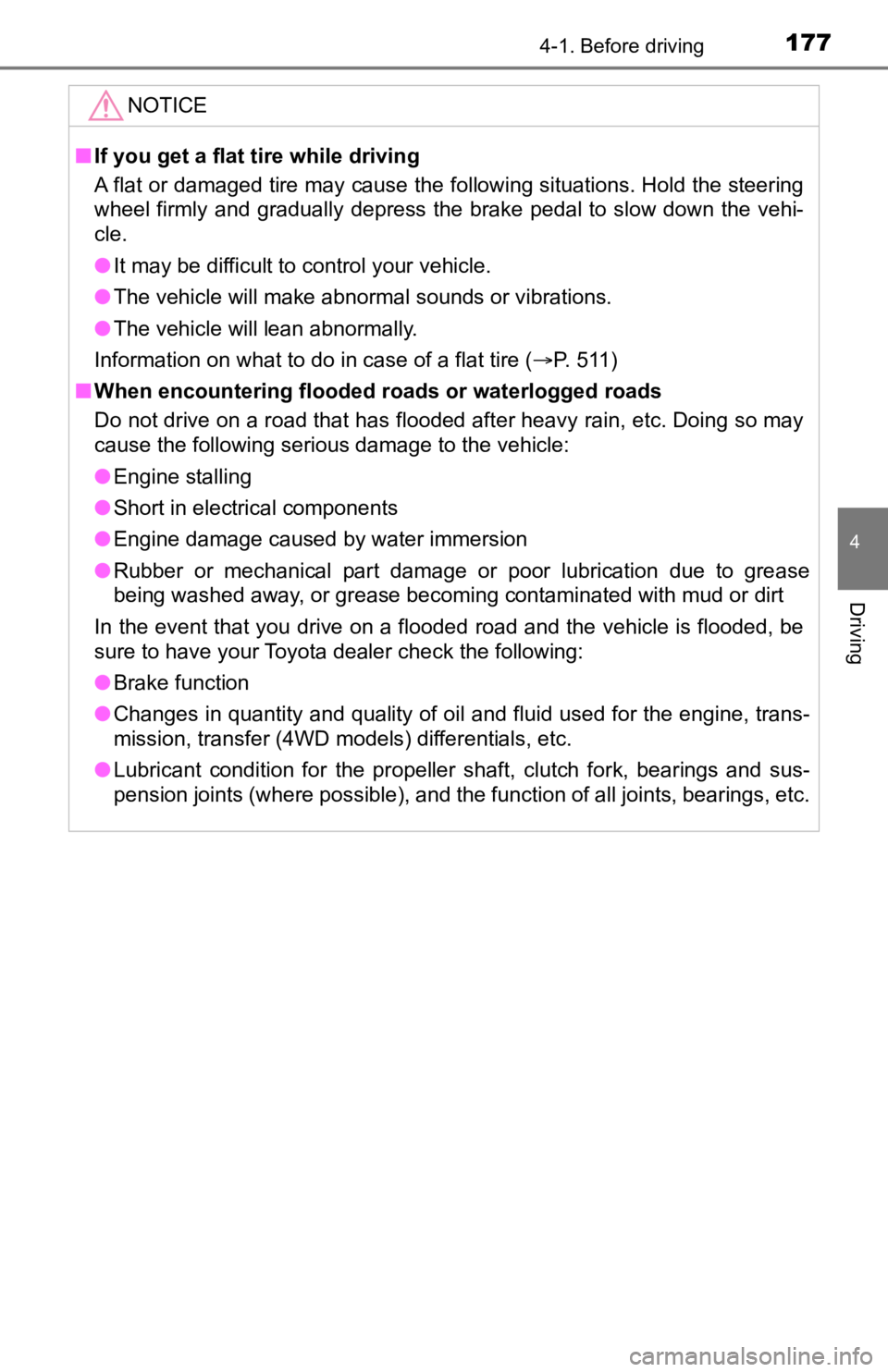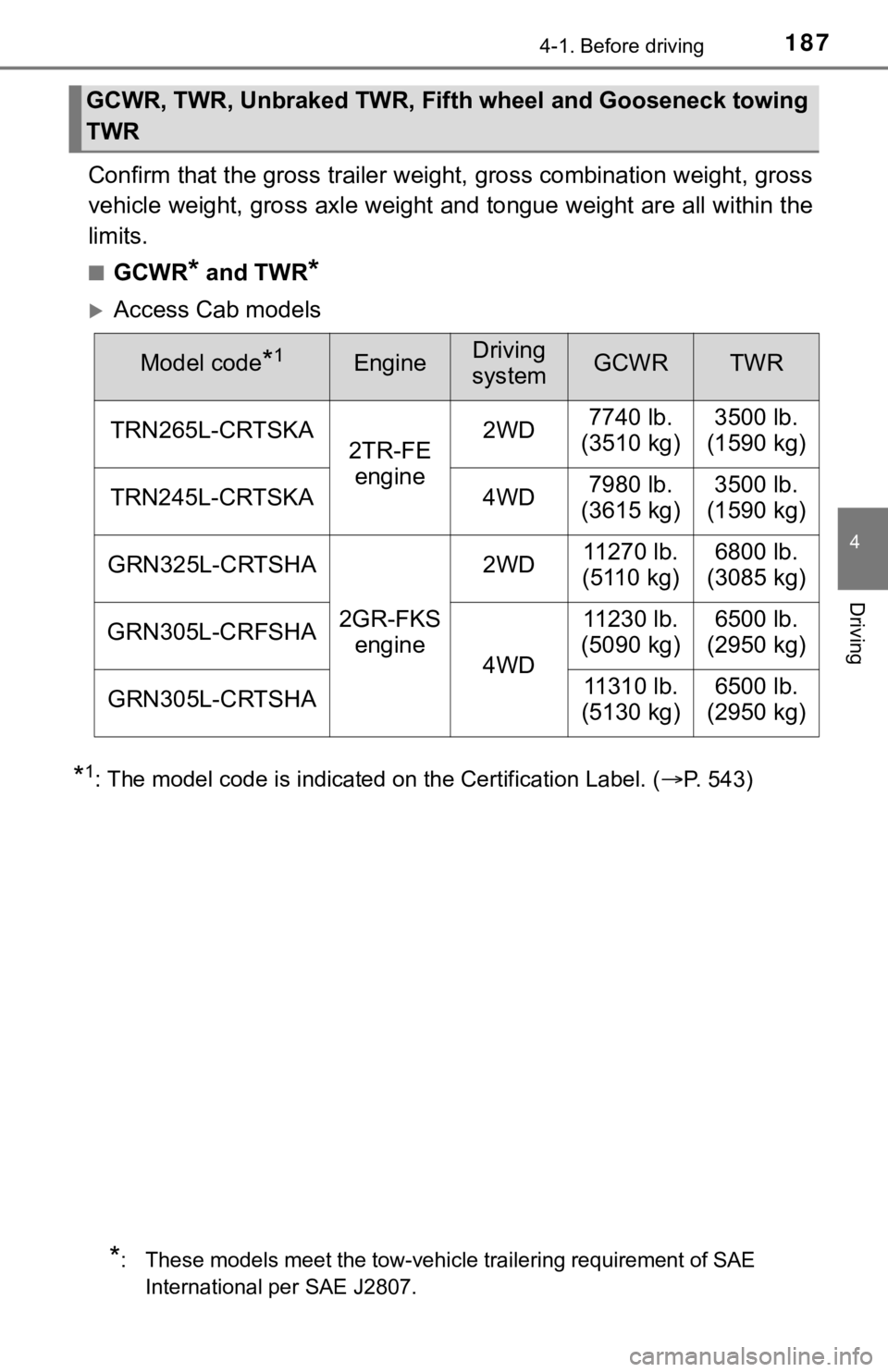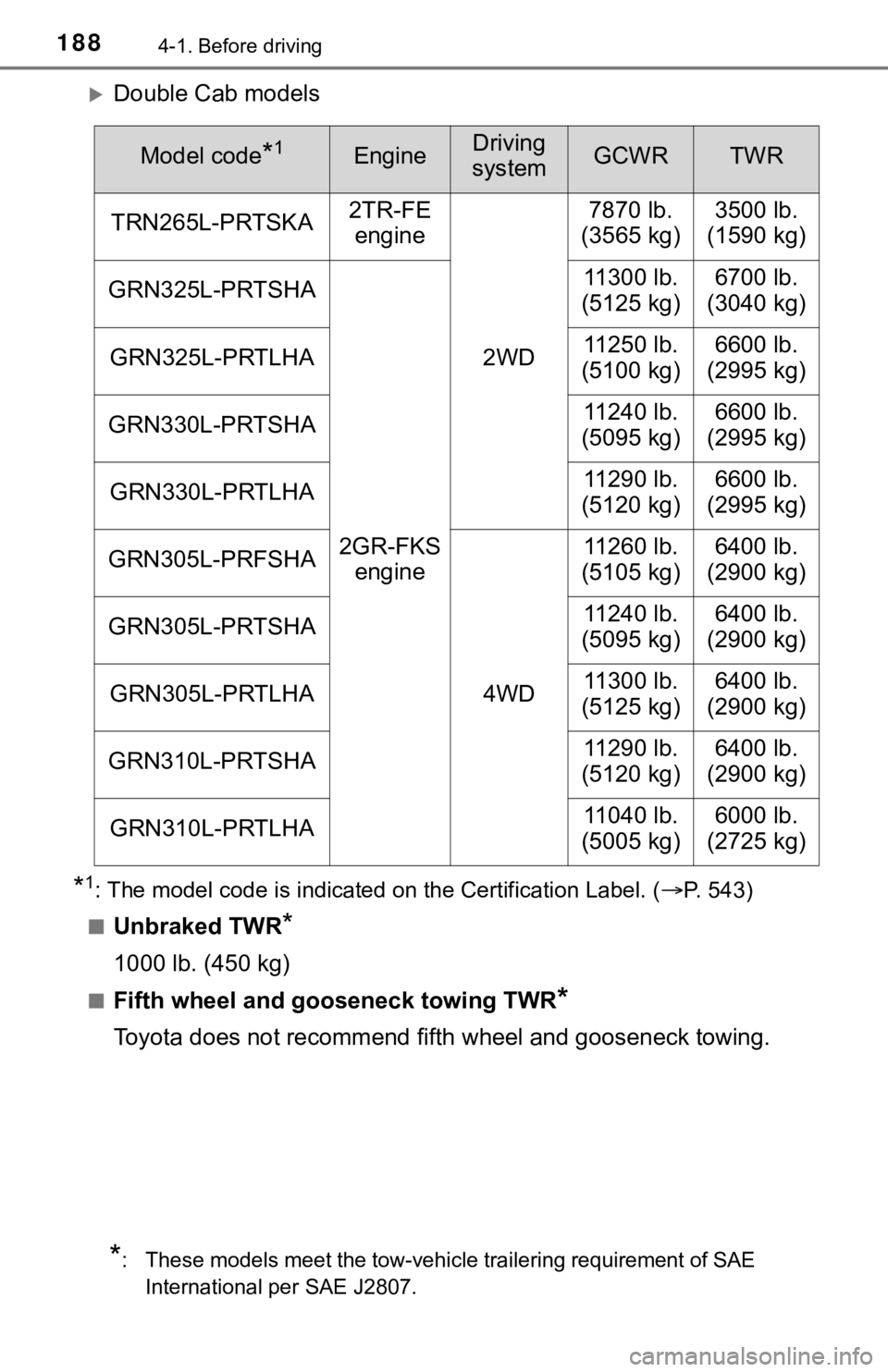2023 TOYOTA TUNDRA 4WD
[x] Cancel search: 4WDPage 93 of 616

932. Instrument cluster
2
Instrument cluster
Warning lights inform the driver of malfunctions in the indicated vehi-
cle’s systems.
Warning lights
*1
(U.S.A.)
Brake system warning
light ( P. 482)
*5
(Flashes
rapidly)
Rear differential lock
indicator ( P. 483)
*1
(Canada)
Brake system warning
light ( P. 482)
(Flashes)
(4WD models)
Low speed four-wheel
drive indicator ( P. 483)
*1
(U.S.A.)
Malfunction indicator
lamp (P. 482)Low fuel level warning
light (P. 483, 493)
*1
(Canada)
Malfunction indicator
lamp ( P. 482)Seat belt reminder light
(P. 483)
*1SRS warning light
(P. 482)
(U.S.A.)
Parking brake indicator
(P. 483)
*1
(U.S.A.)
ABS warning light
(P. 482)
(Canada)
Parking brake indicator
(P. 483)
*1
(Canada)
ABS warning light
(P. 482)
*1
Master warning light
(P. 483)
*1, 2
Slip indicator ( P. 483)
*1, 5Tire pressure warning
light (P. 484)
Page 95 of 616

952. Instrument cluster
2
Instrument cluster
*2: The light comes on to indicate a malfunction.
*3: The light flashes to indicate a malfunction.
*4: This light illuminates on the multi-information display.
*5: If equipped
The indicators inform the driver of the operating state of the vehicle’s
various systems.
Indicators
Turn signal indicator
( P. 218)*2VSC off indicator
(P. 307, 324, 325)
(U.S.A.)
Headlight indicator
(P. 220)
*2
“TRAC OFF” indicator
(P. 324, 325)
(Canada)
Tail light indicator
(P. 220)
*4, 9
Active traction control
system indicator
(P. 312)
Headlight high beam
indicator ( P. 222)
(4WD models)
Four-wheel drive indica-
tor (P. 303)
*9Automatic high beam
indicator ( P. 224)*2, 9
Rear differential lock
indicator (P. 309)
*9Fog light indicator
(P. 229)*4Cruise control indicator
(P. 275, 280)
*1
Power mode indicator
(P. 212)
*4, 9Dynamic radar cruise
control indicator
(P. 271)
*4Cruise control “SET”
indicator ( P. 275, 280)*2“AUTO LSD” indicator
(P. 307)
*2, 3Slip indicator
(P. 307, 312, 318, 324)*2, 9, 10PCS warning light
(P. 249)
Page 96 of 616

962. Instrument cluster
*1: Vehicles with an automatic transmission.
*2: These lights turn on when the engine switch is turned to the “ON” position(vehicles without a smart key system) or IGNITION ON mode (vehi cles
with a smart key system) to indicate that a system check is being per-
formed. They will turn off after the engine is started, or after a few seconds.
There may be a malfunction in a system if the lights do not com e on, or if
the lights do not turn off. Have the vehicle inspected by your Toyota dealer
for details.
*3: The light flashes to indicate that the system is operating.
*4: This light illuminates on the multi-information display.
*5: When the outside temperature is approximately 37°F (3°C) or lo wer, the
indicator will flash for 10 times, then comes on.
*4, 9
(Green)
LDA indicator ( P. 262)
*4, 9
Crawl Control indicator
(P. 318)
(4WD models)
Low speed four-wheel
drive indicator ( P. 303)
*4, 5
Low outside tempera-
ture indicator (P. 98)
(U.S.A.)
Parking brake indicator
(P. 219)
*6, 7, 9BSM outside rear view
mirror indicator
(P. 292)
(Canada)
Parking brake indicator
(P. 219)
*8, 9
Security indicator
(P. 78, 88)
*4, 9
Multi-terrain Select indi-
cator (P. 314)
“AIR BAG ON/OFF” indicators
(P. 48)*2, 8
Page 170 of 616

1704-1. Before driving
■When starting off on an uphill (v ehicles with the hill-start assist control
system)
The hill-start assist control will activate. ( P. 324)
■ Driving in the rain
●Drive carefully when it is raining, because visibility will be reduced, the win-
dows may become fogged-up, and the road will be slippery.
● Drive carefully when it starts to rain, because the road surface will be espe-
cially slippery.
● Refrain from high speeds when driving on an expressway in the r ain,
because there may be a layer of water between the tires and the road sur-
face, preventing the steering and brakes from operating properl y.
■ Engine speed while driving (vehic les with an automatic transmission)
In the following conditions, the engine speed may become high w hile driving.
This is due to automatic up-shifting control or down-shifting implementation to
meet driving conditions. It does not indicate sudden acceleration.
● The vehicle is judged to be driving uphill or downhill
● When the accelerator pedal is released
● When the brake pedal is depressed while power mode is selected
■ Restraining the engine out put (Brake Override System)
● When the accelerator and brake pedals are depressed at the same time, the
engine output may be restrained.
● A warning message is displayed on the multi-information display while the
system is operating. ( P. 493)
■ Restraining sudden start (Drive-Start Control: vehicles with an automatic
transmission)
● When the following unusual operation is performed, the engine o utput may
be restrained.
• When the shift lever is shifted from R to D, D to R, N to R, P to D, or P to
R (D includes S) with the accelerator pedal depressed, a warnin g mes-
sage appears on the multi-information display.
• When the accelerator pedal is depressed too much while the veh icle is in
reverse.
● While Drive-Start Control is being activated, your vehicle may have trouble
escaping from the mud or fresh snow. In such case, perform the following
actions to cancel Drive-Start Control so that the vehicle may b ecome able to
escape from the mud or fresh snow.
• Deactivate TRAC ( P. 324)
• When the AUTO LSD system is turned on.
(P. 307)
• 4WD models: The four-wheel drive control switch is in “4L” pos ition.
(P. 303)
Page 177 of 616

1774-1. Before driving
4
Driving
NOTICE
■If you get a flat tire while driving
A flat or damaged tire may cause the following situations. Hold the steering
wheel firmly and gradually depress the brake pedal to slow down the vehi-
cle.
● It may be difficult to control your vehicle.
● The vehicle will make abnormal sounds or vibrations.
● The vehicle will lean abnormally.
Information on what to do in case of a flat tire ( P. 511)
■ When encountering flooded roads or waterlogged roads
Do not drive on a road that has flooded after heavy rain, etc. Doing so may
cause the following serious damage to the vehicle:
● Engine stalling
● Short in electrical components
● Engine damage caused by water immersion
● Rubber or mechanical part damage or poor lubrication due to grease
being washed away, or grease becoming contaminated with mud or dirt
In the event that you drive on a flooded road and the vehicle is flooded, be
sure to have your Toyota dealer check the following:
● Brake function
● Changes in quantity and quality of oil and fluid used for the engine, trans-
mission, transfer (4WD models) differentials, etc.
● Lubricant condition for the propeller shaft, clutch fork, beari ngs and sus-
pension joints (where possible), and the function of all joints, bearings, etc.
Page 187 of 616

1874-1. Before driving
4
Driving
Confirm that the gross trailer weight, gross combination weight, gross
vehicle weight, gross axle weight and tongue weight are all within the
limits.
■GCWR* and TWR*
Access Cab models
*1: The model code is indicated on the Certification Label. (P. 543)
GCWR, TWR, Unbraked TWR, Fifth wheel and Gooseneck towing
TWR
*: These models meet the tow-vehicle trailering requirement of SAE International per SAE J2807.
Model code*1EngineDriving
systemGCWRTWR
TRN265L-CRTSKA 2TR-FE
engine 2WD
7740 lb.
(3510 kg) 3500 lb.
(1590 kg)
TRN245L-CRTSKA 4WD7980 lb.
(3615 kg) 3500 lb.
(1590 kg)
GRN325L-CRTSHA 2GR-FKS engine 2WD
11270 lb.
(5110 kg) 6800 lb.
(3085 kg)
GRN305L-CRFSHA 4WD11230 lb.
(5090 kg) 6500 lb.
(2950 kg)
GRN305L-CRTSHA 11310 lb.
(5130 kg) 6500 lb.
(2950 kg)
Page 188 of 616

1884-1. Before driving
Double Cab models
*1: The model code is indicated on the Certification Label. (P. 543)
■Unbraked TWR*
1000 lb. (450 kg)
■Fifth wheel and gooseneck towing TWR*
Toyota does not recommend fifth wheel and gooseneck towing.
Model code*1EngineDriving
systemGCWRTWR
TRN265L-PRTSKA 2TR-FE
engine
2WD7870 lb.
(3565 kg) 3500 lb.
(1590 kg)
GRN325L-PRTSHA
2GR-FKS engine 11300 lb.
(5125 kg)
6700 lb.
(3040 kg)
GRN325L-PRTLHA 11250 lb.
(5100 kg)6600 lb.
(2995 kg)
GRN330L-PRTSHA 11240 lb.
(5095 kg)6600 lb.
(2995 kg)
GRN330L-PRTLHA 11290 lb.
(5120 kg)6600 lb.
(2995 kg)
GRN305L-PRFSHA
4WD11260 lb.
(5105 kg)
6400 lb.
(2900 kg)
GRN305L-PRTSHA 11240 lb.
(5095 kg)6400 lb.
(2900 kg)
GRN305L-PRTLHA 11300 lb.
(5125 kg)6400 lb.
(2900 kg)
GRN310L-PRTSHA 11290 lb.
(5120 kg)6400 lb.
(2900 kg)
GRN310L-PRTLHA 11040 lb.
(5005 kg)6000 lb.
(2725 kg)
*: These models meet the tow-vehicle trailering requirement of SAE
International per SAE J2807.
Page 276 of 616

2764-5. Using the driving support systems
■Dynamic radar cruise control can be set when
●Vehicles with an automatic transmission: The shift lever is in D or range 4 or
higher of S has been selected.
● Vehicle speed is at or above approximately 30 mph (50 km/h).
■ Accelerating after setting the vehicle speed
The vehicle can accelerate by operating the accelerator pedal. After acceler-
ating, the set speed resumes. However, during vehicle-to-vehicl e distance
control mode, the vehicle speed may decrease below the set spee d in order
to maintain the distance to the preceding vehicle.
■ Automatic cancelation of vehicle-to-vehicle distance control mo de
Vehicle-to-vehicle distance control mode is automatically cance led in the fol-
lowing situations:
● Actual vehicle speed falls at or below approximately 25 mph (40 km/h).
● VSC is activated.
● TRAC is activated for a period of time.
● When the VSC or TRAC system is turned off.
● The sensor cannot detect correctly because it is covered in some way.
● Pre-collision braking is activated.
● 4WD models: The operation cannot be switched for 5 seconds or m ore after
operating the front-wheel drive control switch.
If vehicle-to-vehicle distance control mode is automatically ca nceled for any
other reason, there may be a malfunction in the system. Contact your Toyota
dealer.